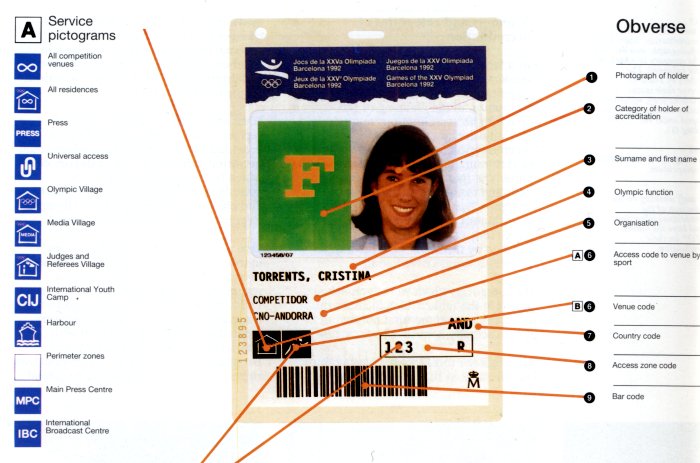Identity Card
Numbers and categories of accreditation For a large part of the organisation, the calculation of the number of accreditations was a basic item of information in the planning of the services. The accreditations team drafted a periodic document called "Accreditation forecasts" as the results of the different agreements gradually took shape. The first figures were calculated according to the requirements of the Olympic Charter (1987 edition), the undertakings of the Candidature and the figures for previous Games, though modified by the increase in the number of sports and venues over Seoul. The categories which were established appear in the table, which includes the first estimate and the total number of people actually accredited per category. Although the total forecast was more or less the same as the final result, an analysis by categories shows significant changes which occurred as a result of external events, mainly the increase in the numbers of journalists and broadcasters, and internal ones, such as the restrictions on the number of guests. Each accreditation category carried certain access privileges and services, provided by the organisation, which could be varied individually. The category code, which figured prominently on the accreditation, helped to identify clearly and efficiently the group of the Olympic Family to which the holder belonged. One novelty introduced at Barcelona'92 in this area was the distinction of guests in two groups: the G/Gv categories for commitments to the institutions, and the Ps/Pb categories for commitments to the associate companies. Another category created was RTL (support staff with restricted access
to the International Broadcast Centre without accommodation rights), which
made it possible to extend the accreditation quotas for the TV networks
without having to take additional commitments for accommodation, access,
etc. Another case was the creation of the SC accreditation for the staff
of the service companies, which consisted of two different elements: the
operations pass, a document without a holder's name which was the same
size as an accreditation and contained the function and access details
(pictograms and zones), and the company card, with a photograph and the
holder's details, which was in a similar format to a credit card. Those
two documents were only valid if they were presented together.
The privileges Within the Olympic Movement and in the context of accreditations the access rights to the Olympic sites of each member of the Olympic Family are known as privileges. Two types of privilege were established: access privileges, represented on the accreditation by a pictogram, which conferred the right of entry to one or more units, and interior movement or zone privileges, coded from 0 to 9, which permitted entry to particular zones of the units. |

Zones
|
When choosing the model for the accreditation card the ones which had been used at other Olympic Games were taken into consideration. The photograph and the name combined had to be the identifying element of the bearer. The card also had to show the function and the organisation to which he or she belonged. The privileges, whether for access or services, had to appear for the guidance of the control staff. The accreditation had to be thick, but also comfortable to carry, for example, in a shirt pocket. Lastly, it had to be equipped with safety devices to prevent forgery or other kinds of manipulation. In comparison with other Games, Barcelona had the added complication of having to prepare the accreditation in different languages, chosen from the four official ones according to the group. Other elements of identification The accreditation was not the only document which was valid for access to the Olympic sites. Alternative identifying elements were also prepared to cover identification and access requirements which did not come under the heading of accreditation. The day pass was a document devised for exceptional, occasional situations. Given the short period of validity of this document, it did not have a photograph and could only be used at the facility where it was issued. Each unit had a day pass management office. Identity Card (OIC), originally contemplated in the Olympic Charter as an accreditation, has been reduced to that of a visa for entry into the host country -which is why it is known as the "Olympic passport"-, although it is not valid unless accompanied by an official passport. This document was approved by the foreign and interior ministries and manufactured by the Fábrica Nacional de Moneda y Timbre (the Mint). We might mention that it is the first official document recognised by both ministries where the texts are also in Catalan. Besides these accreditation elements, there were other special ones for certain activities: the ceremonies pass complemented the accreditation of the operations staff for the opening and closing ceremonies; the ceremonies bracelet identified the artists performing in them, which avoided having to accredit about 8,000 people for a single event; the torch bearers' bracelet identified the runners and cyclists and entitled them to use the transport services to the starting point of their relay; the doping control pass was used by the people with access -including the competitors who had to pass the test- to the special medical zone and was administered by the doping control officer at the venue. Journalists who wished to visit the Olympic Village had to exchange
their accreditation for a special press pass which gave them the right
to enter the international zone only. Similarly, each NOC was entitled
to a number of daily visitors' passes for its members. To distinguish them
from the day passes they were a different colour and entitled the holder
to entry to the residential zone of the Village. The photographer's and
TV cameraman's bib, familiar at all competitions, made it possible to distinguish
the reporters who were entitled to be in the competition area at a distance. (Source Document: Official Report 1992, Vol.
III, page 221 - 222 ) |